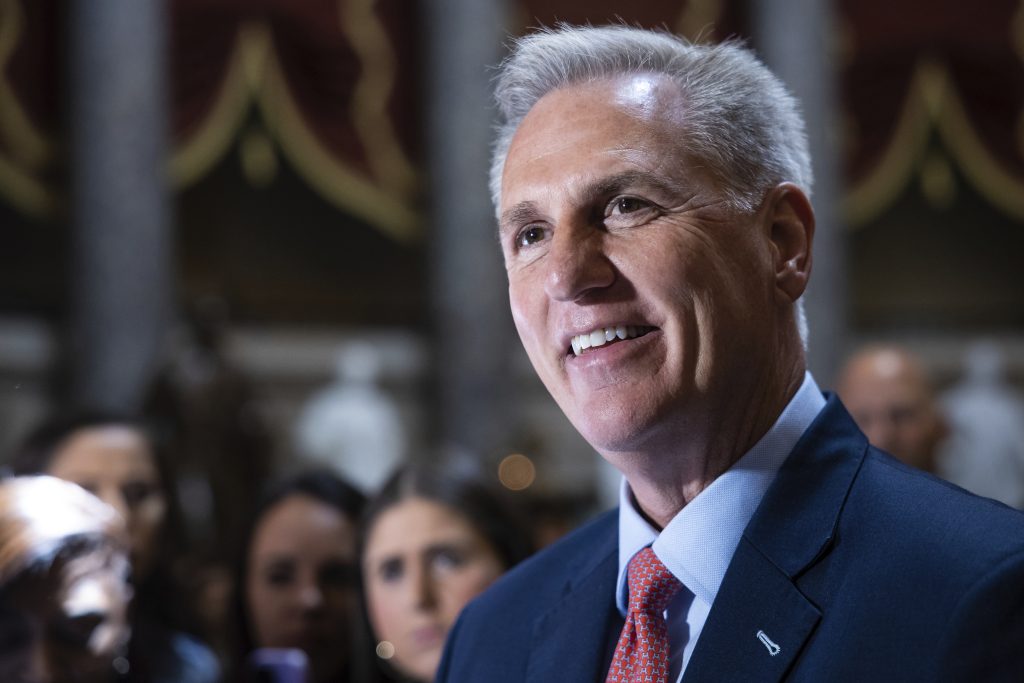White House and congressional GOP negotiators have reached an agreement in principle to avert a debt default, according to two people familiar with the deal. Now they have to get it to President Joe Biden’s desk in time.
Hill leaders will now race to draft and pass the deal as quickly as possible — through both the House and Senate — ahead of the June 5 deadline. And both Biden and Speaker Kevin McCarthy still have to sell their respective parties on the agreement, navigating fraught votes in both chambers.
In addition to lifting the $31.4 trillion borrowing cap through the 2024 presidential election, the deal in principle would keep non-defense spending roughly flat for the fiscal year that begins Oct. 1, according to a person familiar with the negotiations, falling far short of the $130 billion in cuts at fiscal 2022 levels that Republicans had originally demanded.
Non-defense spending would increase by 1 percent in 2025, followed by years of non-enforceable funding targets, according to the person familiar. Republicans had initially pushed for a decade of strict funding limits.
In a win for Biden, defense spending would be set at the level proposed in his budget for the coming fiscal year, representing a modest 3.5 percent increase over current funding levels — less than what many Republican defense hawks would’ve liked to see for the Pentagon in order to keep pace with inflation.
The agreement includes new policy changes to the TANF and SNAP programs, including time limits on people up to age 54, according to a source familiar with the negotiations who was not authorized to share details publicly. The deal would include new work requirements in TANF for cash assistance recipients but a modified version of the House-passed bill. The changes are likely to be unpopular with House Democrats.
But it imposes no new work requirements for Medicaid, a win for the White House.
In other key wins for the White House, the agreement protects the environmental provisions from the Inflation Reduction Act, including clean energy funding. It also doesn’t touch Biden’s student debt relief plan.
Republicans are expected to need a sizable number of Democrats to help them clear the bill through the House amid early signs that conservative members of the Freedom Caucus are unlikely to support a deal that is significantly different than a bill the House passed last month.
But the deal in principle still marks the first major piece of legislation negotiated between the McCarthy-led House GOP and the Biden administration since Republicans took over the majority in January.
Biden and McCarthy spoke on the phone just hours before the deal was announced in an attempt to resolve final sticking points, including a GOP push to include work requirements on social safety net programs. And the agreement followed days of closely watched negotiations between Reps. Garret Graves (R-La.), Patrick McHenry (R-N.C.), OMB Director Shalanda Young and Steve Ricchetti, a trusted Biden counselor.
But Hill leaders and the White House still have major political hurdles to overcome. The grind of the legislative process could push Congress up against the June 5 deadline, when Treasury Secretary Janet Yellen has warned the country will run out of money to pay its bills.
House GOP leaders have pledged to give their members a full 72 hours to review a bill. They’ve bent that rule this year already, but Republicans have vowed they won’t try to truncate the time on any debt limit legislation. Even leadership allies believe doing so would threaten GOP support for the deal.
GOP leadership will brief the conference at 9:30 p.m. on the contours of the agreement by phone late Saturday night, preceding what will likely be a major whipping operation. Though the House left on Thursday for a Memorial Day break, members were warned they might have to return to Washington with 24 hours’ notice.
The bipartisan deal is expected to test McCarthy’s hold on his right flank, including members of the House Freedom Caucus.
Republicans have largely remained unified since they passed their own debt proposal earlier this month, but the bipartisan deal is already sparking criticism from a right-flank that McCarthy has worked to appease in the lead-up to and since becoming speaker.
As negotiators worked Saturday to finalize the deal, GOP Whip Tom Emmer (R-Minn.) and Rep. Guy Reschenthaler (R-Pa.) huddled in McCarthy’s office. Emmer, speaking to reporters, had a message for the conference’s right flank: Don’t believe what you are hearing about a potential deal until you talk to us.
“Our job is to make sure that members are well aware that there is no agreement. … We’re constantly in touch with our members letting them know that what is being reported, you should not accept. There is no agreement,” Emmer said.
In the final hours of the negotiations, members of the House Freedom Caucus were circulating a graphic comparing provisions of the House GOP debt bill with what they expected to be in a deal cut with the “swamp.”
“We could negotiate a ‘deal’ like this with a Democrat House majority. This would essentially be what they wanted,” Rep. Bob Good (R-Va.) said Saturday before a deal was announced.
McCarthy needs to get a majority of his own conference to support the deal, something he predicted Saturday that he wouldn’t “have any problem” doing. But given the all-but-certain conservative rebellion, he’s also going to need votes from House Democrats, who have vocally urged Biden to not bend to GOP demands in order to clinch an agreement.
And as he faced outside pressure from House Democrats, Biden has also sought to portray himself as willing to go to bat for his party’s priorities. Asked Friday about concerns that he could give too much away to Republicans on work requirements, Biden clapped back: “I don’t bow to anybody.”
Even once it clears the House, the bill still needs to go through the Senate, where it is expected to take days to get to a final vote unless all 100 senators agree to speed things up. But a fast-track appears unlikely after Sen. Mike Lee (R-Utah) vowed that he would “use every procedural tool at my disposal to impede a debt-ceiling deal that doesn’t contain substantial spending and budgetary reforms.”







